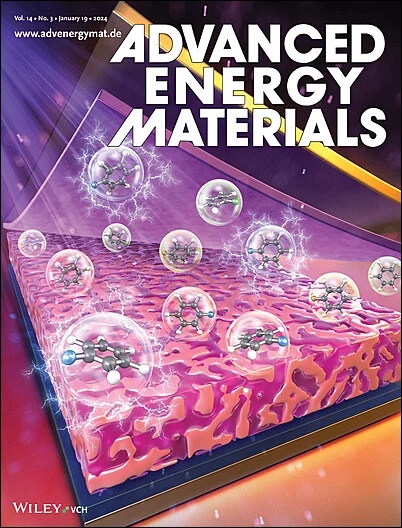通过F掺杂平衡Na3.12Fe2.44(P2O7)2的电子自旋态实现了高钠离子存储性能
IF 26
1区 材料科学
Q1 CHEMISTRY, PHYSICAL
引用次数: 0
摘要
铁基焦磷酸盐Na3.12Fe2.44(P2O7)2 (NFPO)因其低成本、高安全性和开放式大框架结构而备受关注,是一种很有前途的钠离子电池正极材料。然而,由于三维过渡金属Fe的eg轨道中电子分布不均匀而引起的结构不稳定性限制了NFPO的长循环寿命。本文提出了一种自旋态调节策略,通过引入高电负性的氟(F)元素来调节Fe的局部电子结构,实现eg轨道中的电子分布平衡,提高结构稳定性。一系列的分析和密度泛函理论(DFT)计算表明,掺杂F可以诱导Fe的t2g轨道到eg轨道的电子跃迁,使其从中自旋态转变为高自旋态,从而稳定了晶体结构。因此,通过简单的溶胶-凝胶法合成的最佳Na3.08Fe2.44(P2O6.98)2F0.04阴极在0.05℃下具有116.4 mAh g - 1的高容量(理论容量为117 mAh g - 1),以及优越的倍率容量(80℃下61.6 mAh g - 1)和超长的循环寿命(50℃下超过20,000次循环的86.3%的容量保持率)。这项工作为通过调节三维过渡金属的自旋状态来提高聚阴离子正极材料的结构稳定性提供了新的见解。本文章由计算机程序翻译,如有差异,请以英文原文为准。
Balancing Electron Spin States of Na3.12Fe2.44(P2O7)2 Through F‐Doping Realized High Performance on Sodium Ions Storage
Iron‐based pyrophosphate Na3.12 Fe2.44 (P2 O7 )2 (NFPO) has attracted significant attention due to its low cost, high safety, and open large framework structure, as a promising cathode material for sodium ion batteries. However, the structural instability arising from the uneven electron distribution in the eg orbitals of the 3d transition metal Fe limits the long‐cycle life of NFPO. Herein, a spin‐state regulation strategy is proposed by introducing the highly electronegative fluorine (F) element to modulate the local electronic structure of Fe, achieving a balanced electron distribution in the eg orbitals and enhancing structural stability. A range of analyses and density functional theory (DFT) calculations indicate that F doping can induce electron transitions from the t2g to the eg orbitals of Fe, transforming it from an intermediate‐spin state to a high‐spin state, thereby stabilizing the crystal structure. Thus, an optimal Na3.08 Fe2.44 (P2 O6.98 )2 F0.04 cathode synthesized via a simple sol‐gel method exhibits a high capacity of 116.4 mAh g−1 at 0.05 C (theoretical capacity of 117 mAh g−1 ), as well as superior rate capability (61.6 mAh g−1 at 80 C) and ultra‐long cycle life (86.3 % capacity retention rate over 20 000 cycles at 50 C). This work provides new insights into enhancing the structural stability of polyanion cathode materials by regulating the spin state of 3d transition metals.
求助全文
通过发布文献求助,成功后即可免费获取论文全文。
去求助
来源期刊

Advanced Energy Materials
CHEMISTRY, PHYSICAL-ENERGY & FUELS
CiteScore
41.90
自引率
4.00%
发文量
889
审稿时长
1.4 months
期刊介绍:
Established in 2011, Advanced Energy Materials is an international, interdisciplinary, English-language journal that focuses on materials used in energy harvesting, conversion, and storage. It is regarded as a top-quality journal alongside Advanced Materials, Advanced Functional Materials, and Small.
With a 2022 Impact Factor of 27.8, Advanced Energy Materials is considered a prime source for the best energy-related research. The journal covers a wide range of topics in energy-related research, including organic and inorganic photovoltaics, batteries and supercapacitors, fuel cells, hydrogen generation and storage, thermoelectrics, water splitting and photocatalysis, solar fuels and thermosolar power, magnetocalorics, and piezoelectronics.
The readership of Advanced Energy Materials includes materials scientists, chemists, physicists, and engineers in both academia and industry. The journal is indexed in various databases and collections, such as Advanced Technologies & Aerospace Database, FIZ Karlsruhe, INSPEC (IET), Science Citation Index Expanded, Technology Collection, and Web of Science, among others.
 求助内容:
求助内容: 应助结果提醒方式:
应助结果提醒方式:


